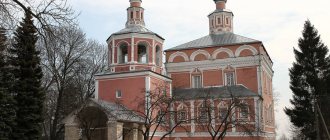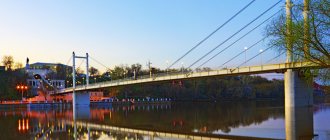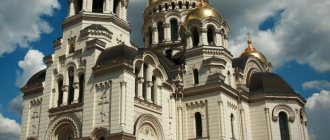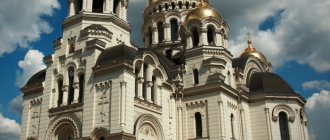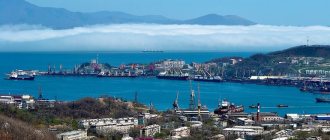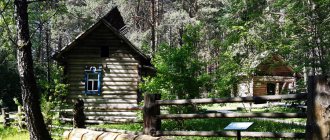The island-city of Sviyazhsk, as if emerging from Russian epics in our time, is located in the Republic of Tatarstan near the mouth of the Sviyaga River and 30 kilometers from Kazan in the upper Volga. The appearance on this small island of an ancient architectural complex is inextricably linked with the name of Ivan the Terrible, who looked for a place on the banks of the Sviyaga to build a fortress with the goal of capturing Kazan. To do this, near the city of Myshkin in 1551, the entire fortress was cut down and, numbered, sent here along the Volga. This is how a fortress town grew up on Mount Bald. Many of the sights of Sviyazhsk arose during the time of Tsar Ivan Vasilyevich and today amaze with their beauty against the backdrop of picturesque nature. Thousands of tourists come every year to see the unique historical and architectural complex and to be spiritually enriched. It is possible that the photos with names and descriptions given in the article will make you want to visit this amazing island city.
Sviyazhsk River Station
The best way to travel to the island of Sviyazhsk is by boat along the river, enjoying the views of the luxurious nature of the Volga region. Mooring to the island near the river station, you will immediately find yourself in the atmosphere of antiquity. The station building, where little has changed since the 19th century, will evoke the pages of Alexander Ostrovsky’s dramas or the movie “Cruel Romance” and will set you up to be in another era, with its inherent spiritual values.
Monastery school building
Behind the St. Nicholas Church there is a small two-story building, which at the beginning of the 19th century housed a monastery school, and in Soviet times, here, as in the bishop’s building, the wards of a mental hospital were located. The building was built at the end of the 17th - beginning of the 18th century, but despite the fact that it is already more than 300 years old, it is still quite durable, and after restoration it looks like new.
Monastic school
Walking around the territory of the Assumption Monastery, one cannot help but notice the snow-white Brotherhood building stretched along the wall.
John the Baptist Monastery
The monastery was founded in 1551 for women who decided to devote themselves to serving God. The fire of 1795 destroyed almost all the monastery buildings. Then the monastery of nuns was transferred to the closed Trinity-Sergius Monastery, where they remained until the revolutionary events of 1917. Today, the St. John the Baptist Monastery has again become a monastery for men. The monastic architectural complex has survived to this day in good condition, and includes churches and buildings inherited from the Trinity-Sergius Monastery and buildings of the 19-20 centuries. There is an architectural and art museum on the territory of the temple complex.
Trinity Church
The oldest temple on the island and the main place of pilgrimage is the Trinity Church, which was built at the same time as the foundation of the fortress in 1551. A wooden church, erected without a single nail, has stood for more than 460 years. Tsar Ivan the Terrible himself attended services there more than once and sent prayers there. The interior of the church is decorated with a carved iconostasis and wooden images of saints. The ancient icons inside the temple give a special divine atmosphere, to which pilgrims from all over Russia seek to offer prayers to God.
Sergievskaya Church
One of the architectural pearls of Sviyazhsk, the Church of St. Sergius of Radonezh, was built in 1604 by order of Tsar Boris Fedorovich. The material for the construction of this single-domed refectory church was white limestone. The temple is distinguished by its laconic decor, characteristic of Pskov church architecture. The outer wall of the porch is decorated with an ancient fresco depicting the Trinity from the Old Testament. According to art historians, the surviving fresco is an enlarged copy of Andrei Rublev’s “Trinity”.
Cathedral in the name of the icon of the Mother of God “Joy of All Who Sorrow”
The cathedral, 32 meters high, built in 1898-1906, is the most grandiose church building in the monastery architectural ensemble. The multi-domed church is lined with red brick in the Russian-Byzantine style. The main spherical dome is surrounded at the bottom by a ring of 16 windows. The three entrances to the cathedral are distinguished by the architecture of portals with openings in the form of arches. The church walls are decorated with pilasters, niches, cornices and friezes at different levels. The interior walls were painted in 1914 with biblical scenes.
Chapel in the Name of the Royal Martyrs
Another attraction of the monastery is the single-domed chapel, built of brick in neo-Byzantine architecture in 1897 near the north-eastern fence of the monastery. It was restored in 2004 and consecrated in honor of Nicholas and Alexandra, the Royal Passion-Bearers who died at the hands of the Bolsheviks. At the entrance to the chapel, visitors stop to bow to an icon depicting the royal family. The chapel has ancient icons that sometimes stream myrrh.
What to see in Sviyazhsk in one day
An incredible number of tourist sites fit into the relatively small territory of Sviyazhsk. It’s impossible to get around them in 1 day, but visiting the “pearls” of the island-city can easily be done in 24 hours.
Sviyazhsk Mother of God Assumption Monastery
- Address: Uspenskaya st., 1.
The monastery was founded in 1555 by decree of Ivan IV the Terrible. The first rector of the monastery was Archimandrite German, who established here one of the first printing houses in Russia for printing service books and the Bible. Thanks to this, the monastery became the main spiritual and educational center of the Kazan diocese, which it remained until the 18th century.
In the middle of the 19th century, the monastery began to slowly decline. Income became less and less, and the monks began to leave the impoverished monastery.
In the 20th century, the monastery suffered several crushing blows. In August 1918, Red Army soldiers invaded its territory and brutally killed the rector, Bishop Ambrose, after which they plundered the churches. In 1923, a tornado broke out over Sviyazhsk, destroying part of the historical buildings.
The monastery stood in dilapidated condition for a long time. In 1994, some buildings were renovated and became a psychiatric clinic.
The revival of the cult complex took place in 1997. After large-scale reconstruction work, the monastery returned to its original appearance: temples, monastic cells, stone fences and monuments destroyed during robbery and hurricane were restored.
Today the Sviyazhsk Mother of God Assumption Monastery is a UNESCO World Heritage Site and is recognized as the main architectural and historical monument of the island city.
Museum of the History of Sviyazhsk
- Address: Uspenskaya street, 22.
The museum is located in four buildings of the state-owned complex, built in the first half of the 19th century. The museum's exhibitions are dedicated to the history of the island and its cultural heritage. The main exhibition occupies the central building. During the excursion, tourists travel to the origins of the provincial town of Sviyazhsk and learn about how its settlers lived in different eras.
It will be no less interesting to visit the “prison” building - a building in which the furnishings of a prison cell from the last century have been recreated down to the smallest detail, and a model hall where a detailed model of the island-city is presented. The miniature composition provides an opportunity to see what Sviyazhsk was like in the 19th century.
The peculiarity of the layout lies in the painstaking detailing. There are models of wooden churches, figurines of peasants, trees and bushes. The model is equipped with a backlight that simulates the change of time of day. With the onset of “night,” the lights come on in the tiny huts.
The museum is ideal for children. The interactive excursion will be interesting for children of any age, and upon completion they will be able to have fun in a children's playroom equipped especially for them.
The best on the site: Entertainment in Kazan for children
Rozhdestvenskaya Square
- Coordinates on the map: 55.772867, 48.662513.
Rozhdestvenskaya Square is one of the most popular vacation spots for city residents. It received its name in honor of the Church of the Nativity of the Blessed Virgin Mary, which was destroyed in the 1930s. Its ruins are located not far from here and are a local landmark.
Tourists are also attracted by the nearby restaurants and cafes, but the main “calling card” of this corner is the observation deck, which offers a beautiful view of the Volga.
Christmas Square is furnished with taste and comfort. For tourists to relax, paths are paved here, comfortable benches and lanterns are installed, thanks to which evening walks are possible. The picturesqueness of the square is added by well-groomed lawns and colorful flower beds. The area is kept clean and in perfect order.
Mother of God Assumption Monastery
The Assumption Monastery of the Mother of God, founded in 1555, is the oldest and richest Orthodox monastery in Tatarstan and the Volga region. Masterpieces of ancient Russian architecture located on the monastery territory are the bell tower of the Church of St. Nicholas the Wonderworker and the Assumption Cathedral. Also in the monastery complex there are buildings from the 17th century - a two-story archimandrite building, reminiscent of a Russian tower, fraternal buildings and churches in honor of Saints Mitrofan of Voronezh and Herman of Kazan.
Assumption Cathedral
The majestic Cathedral of the Assumption of the Blessed Virgin Mary belongs to the authorship of the famous Russian architect Postnik Yakovlev-Brama, who built the Moscow St. Basil's Cathedral. Tourists and believers are amazed by the extensive fragments of fresco painting from 1561, preserved on an area of 1080 square meters. They depict scenes from the Bible, Gospel and apocryphal legends in the manner of Western European church painting. Under the dome of the cathedral you have the opportunity to see an icon depicting St. Christopher with the head of a horse and a unique fresco depicting Ivan the Terrible. The “Ukrainian Baroque” appearance in which the temple appears today was given to it in the 18th century. Then the cathedral, crowned with a new dome, grew due to the addition of 12 kokoshniks.
Church of St. Nicholas the Wonderworker
The building of the St. Nicholas Refectory Church, erected in 1555-1556, became the first stone structure of this type of religious architecture in the entire Volga region. The three-altar church building, modeled on the church-bell tower, was built by Pskov masons and reflected the architectural details characteristic of Pskov churches. Inside the temple there are remains of a fresco depicting the face of St. Nicholas of Mozhaisk. The church-bell tower of St. Nicholas the Wonderworker majestically rises 43 meters above Sviyazhsk and serves as a landmark on the way to the Assumption Monastery.
Cultural and natural landscape of Sviyazhsk.
Comprehensive restoration and reconstruction work in the fortress and cathedrals has been carried out in Sviyazhsk since 2010 under the “Renaissance” program; at the same time, the city’s housing stock is being updated, new premises are being built for cultural institutions, hotels, etc.
In 2022, an application was submitted for inclusion in the list of sites under the protection of UNESCO, the Assumption Monastery and the Trinity Church.
Church of Constantine and Helena
The construction of the Church of Constantine and Helena and its bell tower for the lay inhabitants of the settlement dates back to the end of the 17th century. At the beginning of the 18th century, the church and the separate bell tower were combined into a refectory. Later, the temple was added with two boundaries. The erected stone church turned out to be elegant thanks to the Baroque style decor. Having served parishioners until the 20s of the last century, it was closed until the 90s. After restoration, the church opened to parishioners, pilgrims and tourists. It contains church shrines - icons of the Mother of God, St. Sergius of Radonezh, St. Herman of Kazan with parts of his relics.
Trinity Church
Trinity Church is the oldest building in Sviyazhsk. This wooden structure was made without a single nail. Construction was carried out under the leadership of the first Russian military engineer, clerk Ivan Vyrodkov. It is to him that historians attribute the idea of building Sviyazhsk. The fortress was cut down many kilometers from the site of construction, in the city of Myshkin. Then all the logs were numbered and secretly transported to the banks of Sviyaga. In a matter of days, powerful fortifications were erected 30 kilometers from the then enemy Kazan, which played a huge role in its capture by Russian troops in 1552.
The carved iconostasis, wooden images of saints, and ancient icons give the temple a discreet coziness, and the knowledge that Ivan the Terrible himself could communicate with higher powers here makes the temple one of the most attractive places in Sviyazhsk.
Location: Troitskaya street - 3.
Cannon "Devka's head"
Sviyazhsk, created as a fortress, had the latest weapons for that time - cannons. Each of them was different from the other, had its own name and stood in different places of the fortification. The city's Nativity Gate was defended by the Devkin's Head cannon. She got her name thanks to the image on her gun carriage of a female head, similar to the Gorgon Medusa. The cannon installed in front of the local history museum is a copy, created according to drawings found in ancient chronicles.
Monuments and sculptures of Sviyazhsk
In such a historical center as Sviyazhsk, every little thing is connected with the events of the past. Monuments and sculptures are small, sometimes unnoticeable details, but even they are endowed with a special meaning and preserve the memory of past centuries.
Boat of Paul the First
- GPS coordinates: 55.773759, 48.668211.
The monument is located not far from Zarechny railway station. This is an exact copy of Pavel Petrovich’s wooden boat, on which he traveled from Sviyazhsk to Kazan. The vessel is equipped with two dozen pairs of oars, and on the bow there is a figure of an eagle rapidly flying forward. The boat was built according to drawings and drawings preserved in maritime books of the 18th century.
Cannon "Devka's head"
- Address: Uspenskaya street, 22.
At the entrance to the Museum of the History of Sviyazhsk there is an interesting monument - the “Devka’s Head” cannon, so named because of the bas-relief of the Gorgon Medusa that decorated the cannon.
Modern Sviyazhsk is a peaceful town, but in the 16th century it served as a fortress, and defensive weapons were everywhere here. The "Devka's Head" cannons were especially important, since they were used to protect the main gates of the city. The monument to this weapon is an exact copy of a 16th century cannon. It was created according to ancient drawings discovered in manuscripts from the era of Ivan the Terrible.
Today “Devka’s Head” is one of the exhibits of the historical museum and is a symbol of the ancient fortress city of Sviyazhsk.
Wall of the Communards
- Address: Rozhdestvenskaya Square.
The Wall of the Communards is a granite stele set against the background of a white stone wall. This monument marks the place where Red Guards were executed by firing squad in August 1918. The memorial is located on Rozhdestvenskaya Square, with red carnations planted at its foot.
Monument to the Victims of Political Repression
- Address: Uspenskaya st., 4.
After the end of the Great Patriotic War, Sviyazhsk became a place of mass exile, and Gulag camps settled on its territory, where political prisoners were kept, as well as war veterans who were injured in battle.
The monument in memory of the victims of Stalin's repressions appeared in 2011. It is made in the form of a stone wall with a bronze high relief: an elderly prisoner stretches his hand through the bars, releasing a bird. At the bottom of the high relief there is a memorial inscription in two languages (Russian and Tatar), as well as three lines of barbed wire.
Monument to St. Sergius
- Address: Uspenskaya street, 1.
The stone statue of Sergius of Radonezh was created in 1997, but soon mysteriously disappeared. Several years later, during restoration work, it was found buried in the ground near the walls of the Assumption Cathedral. In 2022, the statue was restored and placed in its original location.
On the occasion of the opening of the monument, the abbot of the monastery, Abbot Simeon, gave an interview in which he noted that the return of the sculpture is an important event in the life of the Sviyazhsk monastery, since it is an important detail of its architectural ensemble and a tribute to the memory of St. Sergius, the spiritual collector of the Russian people.
Don't miss reviews of other cities of Tatarstan - Bolgar, Bugulma, Zelenodolsk, Almetyevsk, Yelabuga, Kazan, Chistopol and Naberezhnye Chelny
Sviyazhsk is a city in which everything breathes history and secrets of the past. To visit here means to plunge into the Middle Ages. Such a trip will give unforgettable emotions and impressions and will be interesting to travelers of any age.
Museum of the History of Sviyazhsk
The Sviyazhsk Historical Museum occupies four government buildings dating back to the first half of the 19th century and united into an integral complex. Reviews from museum visitors indicate that the exhibits, which recreate history through interactive exhibits and panoramas, are impressive. The electronic map shows all excursion routes around Sviyazhsk, by activating which tourists receive a lot of interesting information.
Abbot's corps
In the very corner of the monastery there is a small two-story building of the Abbot's building; in some sources it is also called the Bishop's building. This building was built in the second half of the 17th century and looks very similar to the tower from Russian fairy tales. It is believed that nowhere else in Kazan and its surroundings not a single residential building built in the 17th century has survived - there are churches, but there are no more residential buildings. So the Rector’s building of the Assumption Monastery in Sviyazhsk is a unique architectural monument in its own way. By the way, we saw a similar building in Kostroma when we visited the Ipatiev Monastery.
Abbot's corps of the Assumption Monastery
Bishop's Corps of the Assumption Monastery
During Soviet times, the Rector's building housed the wards of a psychiatric hospital. A little further we will see St. Nicholas Church, which amazes with its power and beauty.
Monument to the victims of Stalin's repressions
After the revolution, Sviyazhsk was used for repression of political prisoners, kept in small monastic cells of up to 18 people. It became a place of executions and torture, as evidenced by the many graves scattered around the island. The monument to the victims of Stalin's repressions reminds us of these tragic times, evoking a feeling of deep compassion. It depicts a block of stone with a prison grate carved into it, through which the hand of a prisoner stuck through with a bird in his hand, symbolizing freedom. The monument stands near the entrance to the island on the side where the dam stands.
Useful information for tourists
Sviyazhsk museums are open seven days a week from 9:00 to 18:00, and on Fridays and Saturdays from 9:00 to 19:00. Tickets for adults cost from 100 to 350 rubles, for schoolchildren, students and pensioners - from 50 to 300 rubles. In order not to overpay, we recommend buying a single ticket to the museum-reserve. It will cost 750 rubles for adults and 530 rubles for schoolchildren, students and pensioners.
Civil War Museum
The exhibitions can be viewed independently or with a guide. A walking sightseeing tour of the island-city for 1.5 hours costs from 150 to 180 rubles per person, and for 2 hours – from 200 to 230 rubles. The staff of the museum-reserve offers interesting thematic excursions with a visit to one of the museums and interactive programs for children.
Tourists like master classes for 200 rubles, where they introduce the basics of blacksmithing, pottery, wickerwork, printed fabrics and weaving. Weapons lovers will enjoy training in the medieval shooting range. Throwing spears, axes, archery and crossbow shooting cost 100 rubles. Everyone is invited to try on military armor and take memorable photos for 50 rubles.
Fire Tower
The interactive program with tea drinking for 140 rubles is very popular. Guests are poured aromatic herbal tea from a samovar and treated to pancakes with jam. It is convenient to have a snack and lunch in the monastery refectory, the restaurant "Tavern", the cafe "Sviyaga", "Lazy Torzhok", "Fisherman's Compound" and "Buyan". A set lunch costs from 220 to 350 rubles.
If you want to stay on the island for the night, rent a room at the Sviyaga Hotel, at the House of Merchant Kamenev Hotel, or at the Pilgrim's House at the monastery.
Museum of the History of Sviyazhsk
"Lazy Torzhok"
You can feel the whole atmosphere of past centuries by visiting the historical reconstruction complex “Lazy Torzhok”, located on Rozhdestvenskaya Square. Here, numerous souvenir shops offer products created by the hands of local craftsmen. On weekends, the square becomes the site of a reenactment of battles between the Tatars and Russians that took place in the 16th century. Those interested can try on the combat armor of warriors and shoot with ancient weapons. There is also the tavern “U Ivana”, where you can try dishes prepared according to medieval recipes.
Chapel in the Name of the Royal Martyrs
A landmark of Sviyazhsk, built in our time, is the chapel in the Name of the Royal Passion-Bearers, consecrated in 2004. It is dedicated to the family of the last Russian emperor, who suffered martyrdom at the hands of the Bolshevik government. At the entrance to the temple there is an icon depicting the royal family. There are many ancient icons in the chapel, some of which stream myrrh from time to time.
Horse yard
Leaving the Lazy Torzhok, take a look at the territory of the horse yard, recognized by tourists as the highlight of Sviyazhsk.
Here you will experience the pleasure of seeing beautiful thoroughbred horses, and enjoy riding in a phaeton and on horseback. You are allowed to feed the beautiful horses and take pictures with them as a souvenir. On the horse yard there is a “Crafts Settlement”, where it is interesting to take part in master classes of potters and blacksmiths, learn how to sew leather goods, master the skills of weaving objects from birch bark or painting clay toys. Crafts Settlement is open from Friday to Sunday. The island's attractions include its amazing natural landscapes, which served as inspiration for painters of different centuries. The view of the island washed by the waters of the river, combined with the grandeur of the temples and the original architecture of civil buildings, will not leave any Russian person indifferent. Since 2007, the island has been connected to the mainland by an eight-kilometer causeway. Now you can get to this wonderful corner of Russian land not only by boat, but also by car.
Location, how to get there, opening hours of the museum.
You can get to Sviyazhsk from Kazan in the following ways:
- Personal car.
You can get there by car by driving along the M7 highway in the direction of the capital of Russia. You need to get to the village of Isakovo and then follow the sign to the city. The journey by private car will take no more than sixty minutes. - Steamboat.
Ships to the island depart from the river station of the capital of Tatarstan. The journey takes no more than two hours. You can board the ship from 6.00 to 20.00. One hour before the ship's departure, you can purchase tickets. In summer, ships depart daily. From the first autumn month to October 16, you can only get to the attraction on weekends. - Bus.
At the bus station of the capital of Tatarstan it is possible to buy a ticket to the town. The route and number of stops may vary for different flights. But most bus routes purposefully take tourists to see the beauty of the city and plunge into the enchanting world of Russian antiquity. Bus tickets are quite affordable. - Electric train.
You can also get to your destination from the capital of Tatarstan by rail. However, you should know that the Sviyazhsk station is located several kilometers from the city itself. The railway junction is located in a neighboring village called Nizhnie Vyazovye. From there you can quickly hitch a ride to the village.


